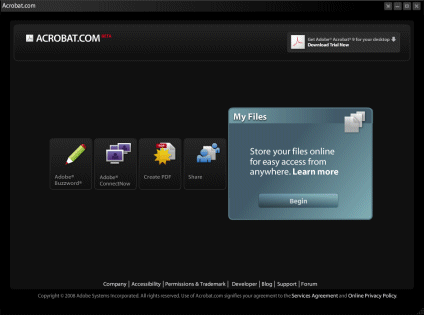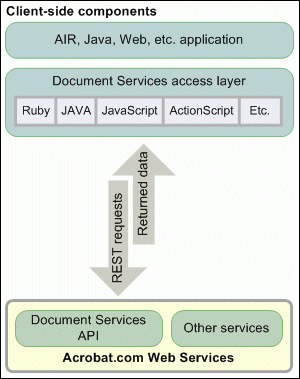My last blog post for IT Week:
Category Archives: adobe
WCF Sessions with Silverlight and Flex
I wanted to adapt my Silverlight CRUD sample (which I also ported to Adobe Flex) to fix a glaring weakness, which is that any user can amend any entry.
I decided to add some logic that allows editing or deleting of only those rows created during the current session. The idea is that a user can amend the entry just made, but not touch any of the others.
WCF has its own session management but this is not supported by the BasicHttpBinding which is required by Silverlight.
Fortunately you can use ASP.NET sessions instead. This means setting your WCF web service for ASP.NET compatibility:
[AspNetCompatibilityRequirements(RequirementsMode = AspNetCompatibilityRequirementsMode.Required)]
Then you can write code using the HttpContext.Current.Session object.
This depends on cookies being enabled on the client. In my simple case it worked fine, in both Silverlight and Flex. In a real app you would probably want to use HTTPS.
I’d post the sample but unfortunately my Windows web space doesn’t support WCF.
Consuming .NET SOAP in Adobe Flex
I wrote up a simple example for The Reg.
As someone has commented, it should work; but I was still pleasantly surprised to find that it succeeded without needing to flatten the WSDL or perform other contortions.
This is essentially the same app as I did in Silverlight; but using Flex instead.
Adobe Reader 9 brings AIR to the world
Adobe has released the free Adobe Reader 9. This includes an AIR application to support Acrobat.com, a document management and collaboration site now in beta. Since Reader gets installed on most of the world’s active computers, this strikes me as a significant moment for Adobe’s new desktop runtime.

The actual application is disappointing. It does not do the main thing laptop users would like it to do, which is to synchronize documents for offline use. Nor does it include a desktop version of Buzzword; the link simply opens your web browser. Finally, the obsession with Flash seems silly. I saved a document as RTF and uploaded it to Acrobat.com by drag-and-drop. Then I double-clicked the document in the list, hoping it would open in Word (or whatever editor is registered for RTF). No luck: the app creates a Flash preview, rather slowly.
In other words, to edit a document I have to download it and then open it. If I want to have the revised version in Acrobat.com, I have to save it and re-upload it.
What’s odd is that Buzzword can open RTF files. So why isn’t there an option to “edit in Buzzword”?
Even going first to Buzzword does not help. Click the Buzzword link, Buzzword opens in your web browser. Go to your documents: you get your Buzzword document store, not your Acrobat store. Wait – there’s an option “to access your other Acrobat.com files click here”. Click. Now I’m in Acrobat.com. Open. No luck: it’s still a Flash preview. Do I really have to download, go back to Buzzword, and re-upload to edit this online?
Microsoft’s SharePoint does this much better. I presume Adobe will fix the Acrobat.com – Buzzword integration, though going further and enabling smooth offline editing and saving in native applications such as Word may be too difficult.
Never mind. This is going to get AIR installed everywhere.
The messy world of the Web 2.0 user interface
Verity Stob’s Web 2.0 app diagram is worth a look.
So is it back to plain old HTML+forms then? That won’t do either; your app will look a decade old, and offline will never work.
This is why the current RIA wars are fascinating – particularly since Apple seems averse to runtimes like Flash, Java or Silverlight on its iPhone.
Which leaves what? JavaScript, hélas.
Have you found an AIR app you actually use yet?
Today I downloaded the BBC’s new Adobe AIR application, BBC Live.

This installs as a system tray app on Windows. It’s a beta. Nice little app; but it’s competing against my existing RSS reader which is subscribed to the BBC news feed. The AIR app is much prettier, has images, and lets you customise the feed easily. However, the RSS reader deals with lots of feeds; and I can’t imagine running a separate application for every one. The advantages of the BBC app are rather small compared to the convenience of using a single application for multiple news sources.
Lifehacker recently published a list of the top ten apps worth installing Adobe AIR for. The list had a contrary affect on me, since there is nothing there that I find really compelling. I tried the eBay Desktop app, for example, but much prefer visiting the web site.
So … personally, I’m still waiting for an AIR app to love. But I’d be interested to know what others are running and finding useful.
Pretty permalinks improve stats reporting
Last month I reconfigured this blog to use WordPress pretty permalinks. I didn’t rush to do this because I don’t mind the default, where the post is identified by a numeric url argument. The new permalinks do look nicer though, and some claim they help search engines, though I haven’t noticed any impact on traffic. The old links still work as well, so nothing got broken.
One advantage of the new arrangement is that awstats does a better job of reporting page views. I can now easily see which posts are the most read. I thought that might be the newer posts, but it is not. The two posts most read last month, by some margin, are both on why Outlook 2007 is slow. The next is one on trouble installing Adobe CS3. Clearly, these are very common frustrations; users hit Google and these posts have a high ranking for these particular subjects.
I value these stats. They tell me (as if I did not already know) that Microsoft has a significant problem with Outlook 2007 performance; and that Adobe needs to work on its installer for Creative Suite. Web 2.0 is great for product feedback.
Adobe’s Acrobat.com REST API
I wrote a piece for IT Week on Adobe Acrobat 9. One aspect of the new Acrobat.com collaboration site that has not received much attention (by way of evidence, the developer forum is currently quiescent) is the document services API. This is a REST API which lets you integrate Acrobat.com services into an application. You can use pretty much any programming language that can talk HTTP. There are some similarities with Amazon’s Simple Storage Service: file upload and download, and management of access control lists based on Adobe IDs (email addresses registered with Adobe). The API reference is here; there are also some wrapper libraries for Java, ActionScript, Ruby, Python and Cold Fusion. No C# yet.

It strikes me as a useful API. For example, imagine you have an application that creates a sales report. The application could upload the report to Acrobat.com and email a group of colleagues with the link.
Another obvious application is a utility to synchronize local and online files. While there are no specific synchronization APIs, you can get the last modified date of a file which would be enough for something simple.
The service will get more useful as other pieces emerge. Flash 10 has a rich text editor with some useful features such as multi-columns with text flow, multi-language and bi-directional support. Put this together with AIR and the Acrobat API and you have all you need to make your own cross-platform offline word processor with online storage. Adobe itself intends to provide this in a future offline version of Buzzword.
Real-world book authoring
Lengthy but worthwhile post on what is it like to write a technical book, from O’Reilly author Baron Schwartz.
Two things that particularly interest me here. One, it is a good account of how much work is involved in writing something worthwhile. Two, the discussion of authoring tools is fascinating: bugs and inadequacies in Open Office and Word.
I have done a couple of quick books; they were low-budget affairs and the process was simpler, but they were still a considerable labour. The first was well received and sold remarkably well. In the second, I misjudged the readership and it bombed. I’d like to do more but I need to block out a large chunk of time, as well as coming up with a winning idea and execution. I’m happy to take a chance on the latter, but finding time is the biggest problem.
For my books I used Pagemaker, and although there were a few annoyances, it never skipped a beat. I’d be quite inclined to use it again, even though it is deprecated in favour of InDesign. Pagemaker’s long document support is excellent. For collaborative authoring though, DocBook might be better.
What’s coming in Buzzword – and Live Writer as Word for the cloud
Interesting post from Lisa Underkoffler’s on what’s coming in Buzzword, Adobe’s internet word processor. She mentions named styles, which I would enjoy since I use these all the time in Word; though I was surprised that it is frequently requested; most people seem happy to apply specific formatting and don’t worry about the structure provided it looks right. Maybe this is Adobe’s strong presence in the print and publishing world showing through.
It prompted me to make a quick tour of the competition to see who already has named style support. Nothing I could see in Google Docs.
Zoho Writer doesn’t seem to have them either.* Zoho’s site also seems a bit temperamental this morning. The connection kept failing which meant a long wait while, perhaps, some AJAX operation was not completing. Zoho froze IE completely; I switched to FireFox but it remained slow. I wish the Zoho folk would stop adding features (even named styles) and focus on performance and reliability for a while; perhaps it is better in the USA.
ThinkFree has them, and they seemed to work (more or less) once I had downloaded its gargantuan Java applet. The company seems to be shifting the emphasis to a downloadable application with online storage, perhaps because the applet is too big for casual use on any old computer. I tried the downloaded application as well. Curiously, after I saved and re-opened the document, my named style disappeared from the list of styles. I think something is not quite right here; I also had a few performance issues.
If you are happy to run a desktop application, Word plus Live Mesh makes a decent and familiar alternative. Just save your document to the Mesh, and open it from anywhere. Main snags: no Mac or Linux support yet, no online editing.
I’ve actually fallen into the habit of using Live Writer plus WordPress as a kind of cloud word processor. Writer has a feature called Post Draft to Weblog. Your document is saved to your blog, but not actually published. Usually I do this for posts that will be published later; but sometimes I use it for notes that will never be published. I can open the draft later from another PC using Writer; or use the online editor in WordPress if Writer is not installed. Another option is to save the draft locally, handy if you are offline; Live Writer will synch it with the online version later. Not recommended for confidential documents, but for casual use it is a powerful combination.
No named styles though. Never mind.
*Update: See comment below: Zoho does support CSS. So if you have a CSS stylesheet set up, you could use these styles in your document. Good idea, though I’m not sure how you go about using this if you are not a skilled web developer.